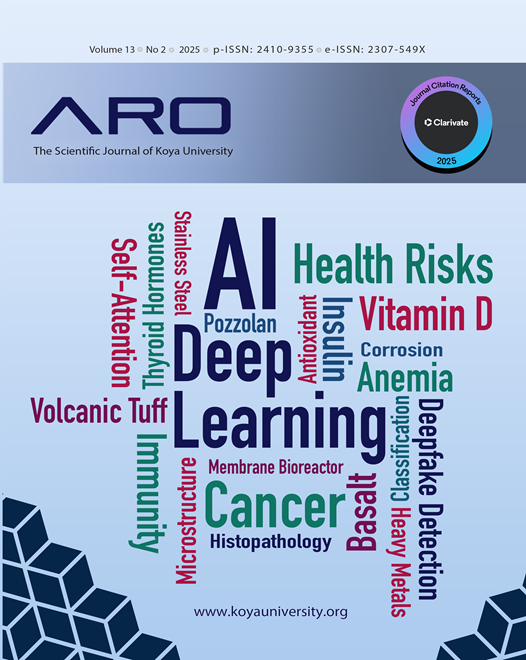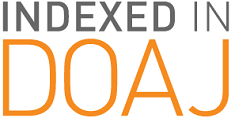Investigating the Relationship Between Insulin-Like Growth Factor-I and Thyroid Hormones in Thyroid Disorder Patients
DOI:
https://doi.org/10.14500/aro.12181Keywords:
Endocrine regulation, Hormonal correlation, Insulin-like growth factor-I, Thyroid disordersAbstract
The insulin-like growth factor I (IGF-I) system plays a pivotal role in endocrine regulation, metabolism, and cellular growth; however, its interaction with thyroid hormones in the context of thyroid dysfunction remains insufficiently understood. This study aimed to investigate the correlations between IGF-I and thyroid hormones, TSH, T3, and T4, in females diagnosed with thyroid disorders. After removing 15 women due to pregnancy or medication use, 160 women from the Koya district were assessed. Serum levels of IGF-I and thyroid hormones were measured using the COBAS e411 analyzer, and body mass index (BMI) was also recorded. Statistical analysis was conducted using SPSS 25, employing Kruskal-Wallis ANOVA and Spearman correlation for thyroid groups: hyperthyroid, hypothyroid, and euthyroid. The results demonstrated significant variation in IGF-I levels across thyroid conditions. IGF-I was markedly elevated in hyperthyroid individuals and showed a moderate inverse correlation with TSH, along with a positive correlation with T3 and T4. Hypothyroid individuals exhibited significantly lower IGF-I levels, suggesting a regulatory role of IGF-I in thyroid hormone dynamics. Additionally, BMI varied significantly across groups (p < 0.001), with the highest values are observed in hypothyroid participants, supporting the metabolic implications of thyroid dysfunction and its association with IGF-I. The study concludes that IGF-I could serve as a valuable adjunct biomarker in the assessment of thyroid disorders, particularly in ambiguous or subclinical cases. Incorporating IGF-I into routine thyroid evaluation may enhance early detection, risk stratification, and individualized management strategies, contributing to more precise and effective endocrine care.
Downloads
References
Adamek, A., and Kasprzak, A., 2018. Insulin-like growth factor (IGF) system in liver diseases. International Journal of Molecular Sciences, 19, p.1308. DOI: https://doi.org/10.3390/ijms19051308
Al-Bayati, A., and Al-Khateeb, S. 2021. The effects of thyroid hormones and their abnormalities on intestinal and hepatic glucose metabolism. Scholars International Journal of Biochemistry, 4, pp.26-36. DOI: https://doi.org/10.36348/sijb.2021.v04i03.002
Anandkumar, S., Chacko, J., and Usha, M. 2020. Thyroid disorder: An overview. Research Journal of Pharmacology and Pharmacodynamics, 12, pp.1-4. DOI: https://doi.org/10.5958/2321-5836.2020.00001.4
Babić Leko, M., Gunjača, I., Pleić, N., and Zemunik, T. 2021. Environmental factors affecting thyroid-stimulating hormone and thyroid hormone levels. International Journal of Molecular Sciences, 22, p.6521. DOI: https://doi.org/10.3390/ijms22126521
Bailes, J., and Soloviev, M. 2021. Insulin-like growth factor-1 (IGF-1) and its monitoring in medical diagnostic and in sports. Biomolecules, 11, p.217. DOI: https://doi.org/10.3390/biom11020217
Chadt, A., and Al-Hasani, H. 2020. Glucose transporters in adipose tissue, liver, and skeletal muscle in metabolic health and disease. Pflügers Archiv-European Journal of Physiology, 472, pp.1273-1298. DOI: https://doi.org/10.1007/s00424-020-02417-x
De Stefano, M.A., Ambrosio, R., Porcelli, T., Orlandino, G., Salvatore, D., and Luongo, C. 2021. Thyroid hormone action in muscle atrophy. Metabolites, 11, p.730. DOI: https://doi.org/10.3390/metabo11110730
Dogansen, S.C., Salmaslioglu, A., Yalin, G.Y., Tanrikulu, S., and Yarman,S. 2019. Evaluation of the natural course of thyroid nodules in patients with acromegaly. Pituitary, 22, pp.29-36. DOI: https://doi.org/10.1007/s11102-018-0923-1
Girnita, L., Smith, T.J., and Janssen, J.A. 2022. It takes two to tango: IGF-I and TSH receptors in thyroid eye disease. The Journal of Clinical Endocrinology and Metabolism, 107, S1. DOI: https://doi.org/10.1210/clinem/dgac045
Hasoon, D., Hadi, M., Naji, T., and Bahrami, A. 2022. Evaluation of the role of insulin-like growth factor-1 and some minerals in treatment of hypothyroid rats: Hormonal study. International Journal of Health Sciences, 6, pp.7588-7598. DOI: https://doi.org/10.53730/ijhs.v6nS3.7762
Iglesias, P., Bayon, C., Mendez, J., Gancedo, P.G., Grande, C., and Diez, J. 2001. Serum insulin-like growth factor type 1, insulin-like growth factor-binding protein-1, and insulin-like growth factor-binding protein-3 concentrations in patients with thyroid dysfunction. Thyroid, 11, pp.1043-1048. DOI: https://doi.org/10.1089/105072501753271734
Karagiannis, A., Kassi, E., Chatzigeorgiou, A., and Koutsilieris, M. 2020. IGF bioregulation system in benign and Malignant thyroid nodular disease: A systematic review. In Vivo, 34, pp.3069-3091. DOI: https://doi.org/10.21873/invivo.12141
Krieger, C.C., Neumann, S., Place, R.F., Marcus-Samuels, B., and Gershengorn, M.C. 2015. Bidirectional TSH and IGF-1 receptor cross talk mediates stimulation of hyaluronan secretion by Graves’ disease immunoglobins. The Journal of Clinical Endocrinology and Metabolism, 100, pp.1071-1077. DOI: https://doi.org/10.1210/jc.2014-3566
Krieger, C.C., Place, R.F., Bevilacqua, C., Marcus-Samuels, B., Abel, B.S., Skarulis, M.C., Kahaly, G.J., Neumann, S., and Gershengorn, M.C. 2016. TSH/IGF-1 receptor cross talk in Graves’ ophthalmopathy pathogenesis. The Journal of Clinical Endocrinology and Metabolism, 101, pp.2340-2347. DOI: https://doi.org/10.1210/jc.2016-1315
Ławnicka, H., Motylewska, E., Borkowska, M., Kuzdak, K., Siejka, A., Świętosławski, J., Stępień, H., and Stępień, T. 2020. Elevated serum concentrations of IGF-1 and IGF-1R in patients with thyroid cancers. Biomedical Papers-Olomouc, 164, 77-83. DOI: https://doi.org/10.5507/bp.2019.018
Liu, B., and Wang, Y. 2024. Predictive value of IGF-1/IGFBP-3 ratio for thyroid nodules in type 2 diabetic mellitus. Frontiers in Endocrinology, 15, p.1444279. DOI: https://doi.org/10.3389/fendo.2024.1444279
Mahdavi, M., Amouzegar, A., Mehran, L., Madreseh, E., Tohidi, M., and Azizi, F. 2021. Investigating the prevalence of primary thyroid dysfunction in obese and overweight individuals: Tehran thyroid study. BMC Endocrine Disorders, 21, p.89. DOI: https://doi.org/10.1186/s12902-021-00743-4
Roa Dueñas, O.H., Xu, Y., Ikram, M.A., Peeters, R.P., Visser, E., and Chaker, L. 2025. Thyroid function and anthropometric measures: A systematic review and meta-analysis. Endocrine Practice, 31, pp.198-207. DOI: https://doi.org/10.1016/j.eprac.2024.11.011
Rochel, D., Burger, M., Nguyen, P., and Jaillardon, L. 2018. Insulin-like growth factor type 1 concentrations in hyperthyroid cats before and after treatment with thiamazole. Journal of Feline Medicine and Surgery, 20, pp.179-183. DOI: https://doi.org/10.1177/1098612X17694735
Sabatino, L., and Vassalle, C. 2025. Thyroid hormones and metabolism regulation: Which role on brown adipose tissue and browning process? Biomolecules, 15, p.361. DOI: https://doi.org/10.3390/biom15030361
Smith, T.J. 2021a. Insulin-like growth factor pathway and the thyroid. Frontiers in Endocrinology, 12, p.653627.
Smith, T.J. 2021b. Insulin-like growth factor pathway and the thyroid. Frontiers in Endocrinology, 12, p.653627. DOI: https://doi.org/10.3389/fendo.2021.653627
Tseng, F.Y., Chen, Y.T., Chi, Y.C., Chen, P.L., and Yang, W.S. 2019. Serum levels of insulin-like growth factor 1 are negatively associated with log transformation of thyroid-stimulating hormone in Graves’ disease patients with hyperthyroidism or subjects with euthyroidism: A prospective observational study. Medicine, DOI: https://doi.org/10.1097/MD.0000000000014862
98, p.e14862.
Vargas-Ortega, G., Romero-Gameros, C.A., Rendón-Macias, M.E., Balcázar-Hernández, L., Sosa-Eroza, E., Mercado, M., de Los Monteros, A.L.E., Pérez-Aguilar, B., Paredes-Manjarrez, C., and Reyes-Olhagaray, F.B. 2021. Risk factors associated with thyroid nodular disease in acromegalic patients: A case-cohort study in a tertiary center. Growth Hormone and IGF Research, 60, p. 101431. DOI: https://doi.org/10.1016/j.ghir.2021.101431
Völzke, H., Friedrich, N., Schipf, S., Haring, R., Lüdemann, J., Nauck, M., Dörr, M., Brabant, G., and Wallaschofski, H. 2007. Association between serum insulin-like growth factor-I levels and thyroid disorders in a population-based study. The Journal of Clinical Endocrinology and Metabolism, 92, pp.4039-4045. DOI: https://doi.org/10.1210/jc.2007-0816
Downloads
Published
How to Cite
Issue
Section
License
Copyright (c) 2025 Aveen M. Asaad, Ismail S. Kakey

This work is licensed under a Creative Commons Attribution-NonCommercial-ShareAlike 4.0 International License.
Authors who choose to publish their work with Aro agree to the following terms:
-
Authors retain the copyright to their work and grant the journal the right of first publication. The work is simultaneously licensed under a Creative Commons Attribution License [CC BY-NC-SA 4.0]. This license allows others to share the work with an acknowledgement of the work's authorship and initial publication in this journal.
-
Authors have the freedom to enter into separate agreements for the non-exclusive distribution of the journal's published version of the work. This includes options such as posting it to an institutional repository or publishing it in a book, as long as proper acknowledgement is given to its initial publication in this journal.
-
Authors are encouraged to share and post their work online, including in institutional repositories or on their personal websites, both prior to and during the submission process. This practice can lead to productive exchanges and increase the visibility and citation of the published work.
By agreeing to these terms, authors acknowledge the importance of open access and the benefits it brings to the scholarly community.
Accepted 2025-07-05
Published 2025-07-20
















 ARO Journal is a scientific, peer-reviewed, periodical, and diamond OAJ that has no APC or ASC.
ARO Journal is a scientific, peer-reviewed, periodical, and diamond OAJ that has no APC or ASC.